Importance of Binding Affinity for the Activity of a Metallodendritic Chemical Nuclease
Abstract
1. Introduction
2. Materials and Methods
2.1. DNA Binding Affinity
2.2. Nuclease Activity
2.3. Reactive Oxygen Species (ROS) Responsible for DNA Cleavage
2.4. Determination of Hydroxyl Radicals
3. Results and Discussion
4. Conclusions
Supplementary Materials
Author Contributions
Funding
Conflicts of Interest
References
- Astruc, D.; Ornelas, C.; Ruiz, J. Metallocenyl Dendrimers and Their Applications in Molecular Electronics, Sensing, and Catalysis. Acc. Chem. Res. 2008, 41, 841–856. [Google Scholar] [CrossRef] [PubMed]
- Newkome, G.R.; He, E.; Moorefield, C.N. Suprasupermolecules with Novel Properties: Metallodendrimers. Chem. Rev. 1999, 99, 1689–1746. [Google Scholar] [CrossRef] [PubMed]
- Tang, Y.-H.; Huang, A.Y.; Chen, P.-Y.; Chen, H.-T.; Kao, C.-L. Metallodendrimers and Dendrimer Nanocomposites. Curr. Pharm. Des. 2011, 17, 2308–2330. [Google Scholar] [CrossRef] [PubMed]
- Corbin, D.A.; Shircliff, D.M.; Reeves, B.J.; Boardman, B.M. Metallopolymers from direct polymerization of functionalized cobalt chalcogenide clusters and thiophene comonomers. Polym. Chem. 2017, 8, 3801–3809. [Google Scholar] [CrossRef]
- Greenfield, J.L.; Rizzuto, F.J.; Goldberga, I.; Nitschke, J.R. Self-Assembly of Conjugated Metallopolymers with Tunable Length and Controlled Regiochemistry. Angew. Chem. Int. Ed. 2017, 56, 7541–7545. [Google Scholar] [CrossRef] [PubMed]
- Zhang, K.Y.; Liu, S.; Zhao, Q.; Huang, W. Stimuli–responsive metallopolymers. Coord. Chem. Rev. 2016, 319, 180–195. [Google Scholar] [CrossRef]
- Vishwanath, R.S.; Kandaiah, S. Metal ion-containing C3N3S3 coordination polymers chemisorbed to a copper surface as acid stable hydrogen evolution electrocatalysts. J. Mater. Chem. A 2017, 5, 2052–2065. [Google Scholar]
- Liang, Y.; Strohecker, D.; Lynch, V.; Holliday, B.J.; Jones, R.A. A Thiophene-Containing Conductive Metallopolymer Using an Fe(II) Bis(terpyridine) Core for Electrochromic Materials. ACS Appl. Mater. Interfaces 2016, 8, 34568–34580. [Google Scholar] [CrossRef]
- Caminade, A.-M.; Ouali, A.; Laurent, R.; Turrin, C.-O.; Majoral, J.-P. Coordination chemistry with phosphorus dendrimers. Applications as catalysts, for materials, and in biology. Coord. Chem. Rev. 2016, 308, 478–497. [Google Scholar] [CrossRef]
- Verma, S.; Srivatsan, S.G.; Claussen, C.A.; Long, E.C. DNA strand scission by a Cu(I)·adenylated polymeric template: Preliminary mechanistic and recycling studies. Bioorg. Med. Chem. Lett. 2003, 13, 2501–2504. [Google Scholar] [CrossRef]
- Melvin, M.S.; Tomlinson, J.T.; Saluta, G.R.; Kucera, G.L.; Lindquist, N.; Manderville, R.A. Double-Strand DNA Cleavage by Copper·Prodigiosin. J. Am. Chem. Soc. 2000, 122, 6333–6334. [Google Scholar] [CrossRef]
- Zandarashvili, L.; Esadze, A.; Vuzman, D.; Kemme, C.A.; Levy, Y.; Iwahara, J. Balancing between affinity and speed in target DNA search by zinc-finger proteins via modulation of dynamic conformational ensemble. Proc. Natl. Acad. Sci. USA 2015, 112, E5142–E5149. [Google Scholar] [CrossRef] [PubMed]
- Wang, X.-L.; Chao, H.; Li, H.; Hong, X.-L.; Ji, L.-N.; Li, X.-Y. Synthesis, crystal structure and DNA cleavage activities of copper(II) complexes with asymmetric tridentate ligands. J. Inorg. Biochem. 2004, 98, 423–429. [Google Scholar] [CrossRef] [PubMed]
- Jiang, Q.; Xiao, N.; Shi, P.; Zhu, Y.; Guo, Z. Design of artificial metallonucleases with oxidative mechanism. Coord. Chem. Rev. 2007, 251, 1951–1972. [Google Scholar] [CrossRef]
- Li, Y.; Wu, Y.; Zhao, J.; Yang, P. DNA-binding and cleavage studies of novel binuclear copper(II) complex with 1,1′-dimethyl-2,2′-biimidazole ligand. J. Inorg. Biochem. 2007, 101, 283–290. [Google Scholar] [CrossRef] [PubMed]
- Liu, C.; Wang, M.; Zhang, T.; Sun, H. DNA hydrolysis promoted by di- and multi-nuclear metal complexes. Coord. Chem. Rev. 2004, 248, 147–168. [Google Scholar] [CrossRef]
- Hurley, A.L.; Mohler, D.L. Organometallic Photonucleases: Synthesis and DNA-Cleavage Studies of Cyclopentadienyl Metal-Substituted Dendrimers Designed To Increase Double-Strand Scission. Org. Lett. 2000, 2, 2745–2748. [Google Scholar] [CrossRef]
- Teyssot, M.-L.; Jarrousse, A.-S.; Chevry, A.; De Haze, A.; Beaudoin, C.; Manin, M.; Nolan, S.P.; Díez-González, S.; Morel, L.; Gautier, A. Toxicity of Copper(I)–NHC Complexes Against Human Tumor Cells: Induction of Cell Cycle Arrest, Apoptosis, and DNA Cleavage. Chemistry 2009, 15, 314–318. [Google Scholar] [CrossRef]
- Mack, D.P.; Iverson, B.L.; Dervan, P.B. Design and chemical synthesis of a sequence-specific DNA-cleaving protein. J. Am. Chem. Soc. 1988, 110, 7572–7574. [Google Scholar] [CrossRef]
- Suntharalingam, K.; Hunt, D.J.; Duarte, A.A.; White, A.J.P.; Mann, D.J.; Vilar, R. A Tri-copper(II) Complex Displaying DNA-Cleaving Properties and Antiproliferative Activity against Cancer Cells. Chemistry 2012, 18, 15133–15141. [Google Scholar] [CrossRef]
- Mancin, F.; Scrimin, P.; Tecilla, P.; Tonellato, U. Artificial metallonucleases. Chem. Commun. 2005, 20, 2540–2548. [Google Scholar] [CrossRef] [PubMed]
- Tan, J.D.; Hudson, S.E.; Brown, S.J.; Olmstead, M.M.; Mascharak, P.K. Syntheses, structures, and reactivities of synthetic analogs of the three forms of cobalt(III)-bleomycin: Proposed mode of light-induced DNA damage by the cobalt(III) chelate of the drug. J. Am. Chem. Soc. 1992, 114, 3841–3853. [Google Scholar] [CrossRef]
- El Amrani, F.B.A.; Perelló, L.; Real, J.A.; González-Alvarez, M.; Alzuet, G.; Borrás, J.; García-Granda, S.; Montejo-Bernardo, J. Oxidative DNA cleavage induced by an iron(III) flavonoid complex: Synthesis, crystal structure and characterization of chlorobis(flavonolato)(methanol) iron(III) complex. J. Inorg. Biochem. 2006, 100, 1208–1218. [Google Scholar] [CrossRef] [PubMed]
- Wende, C.; Lüdtke, C.; Kulak, N. Copper Complexes of N-Donor Ligands as Artificial Nucleases. Eur. J. Inorg. Chem. 2014, 16, 2597–2612. [Google Scholar] [CrossRef]
- Soler, M.; Figueras, E.; Serrano-Plana, J.; González-Bártulos, M.; Massaguer, A.; Company, A.; Martínez, M.Á.; Malina, J.; Brabec, V.; Feliu, L.; Planas, M.; et al. Design, Preparation, and Characterization of Zn and Cu Metallopeptides Based On Tetradentate Aminopyridine Ligands Showing Enhanced DNA Cleavage Activity. Inorg. Chem. 2015, 54, 10542–10558. [Google Scholar] [CrossRef] [PubMed]
- Zhiryakova, M.V.; Izumrudov, V.A. Interaction of Astramol Poly(propyleneimine) Dendrimers with DNA and Poly(methacrylate) Anion in Water and Water–Salt Solutions. J. Phys. Chem. B 2014, 118, 8819–8826. [Google Scholar] [CrossRef] [PubMed]
- Jin, Y.; Cowan, J.A. DNA Cleavage by Copper−ATCUN Complexes. Factors Influencing Cleavage Mechanism and Linearization of dsDNA. J. Am. Chem. Soc. 2005, 127, 8408–8415. [Google Scholar] [CrossRef]
- Kao, C.-L.; Tang, Y.-H.; Lin, Y.C.; Chiu, L.-T.; Chen, H.-T.; Hsu, S.C.N.; Hsieh, K.-C.; Lu, C.-Y.; Chen, Y.-L. Copper complex of a pyridine-modified poly(amidoamine) dendrimer as a chemical nuclease: Synthetic and catalytic study. Nanomedicine 2011, 7, 273–276. [Google Scholar] [CrossRef]
- Tang, Y.-H.; Lin, Y.C.; Hsu, S.C.N.; Liou, S.-T.; Chen, H.-Y.; Hsieh, K.-C.; Chuang, W.-J.; Chiu, L.-T.; Chen, Y.-L.; Kao, C.-L. Cooperative Effects in Copper Polyamidoamine Dendrimer Complexes Catalyzing the Reduction of Molecular Oxygen. Eur. J. Inorg. Chem. 2015, 29, 4839–4847. [Google Scholar] [CrossRef]
- Healey, D.F.; Strothkamp, K.G. Inhibition of the catecholase and cresolase activity of mushroom tyrosinase by azide. Arch. Biochem. Biophys. 1981, 211, 86–91. [Google Scholar] [CrossRef]
- Tang, Y.-H.; Cangiotti, M.; Kao, C.-L.; Ottaviani, M.F. EPR Characterization of Copper(II) Complexes of PAMAM-Py Dendrimers for Biocatalysis in the Absence and Presence of Reducing Agents and a Spin Trap. J. Phys. Chem. B 2017, 121, 10498–10507. [Google Scholar] [CrossRef] [PubMed]
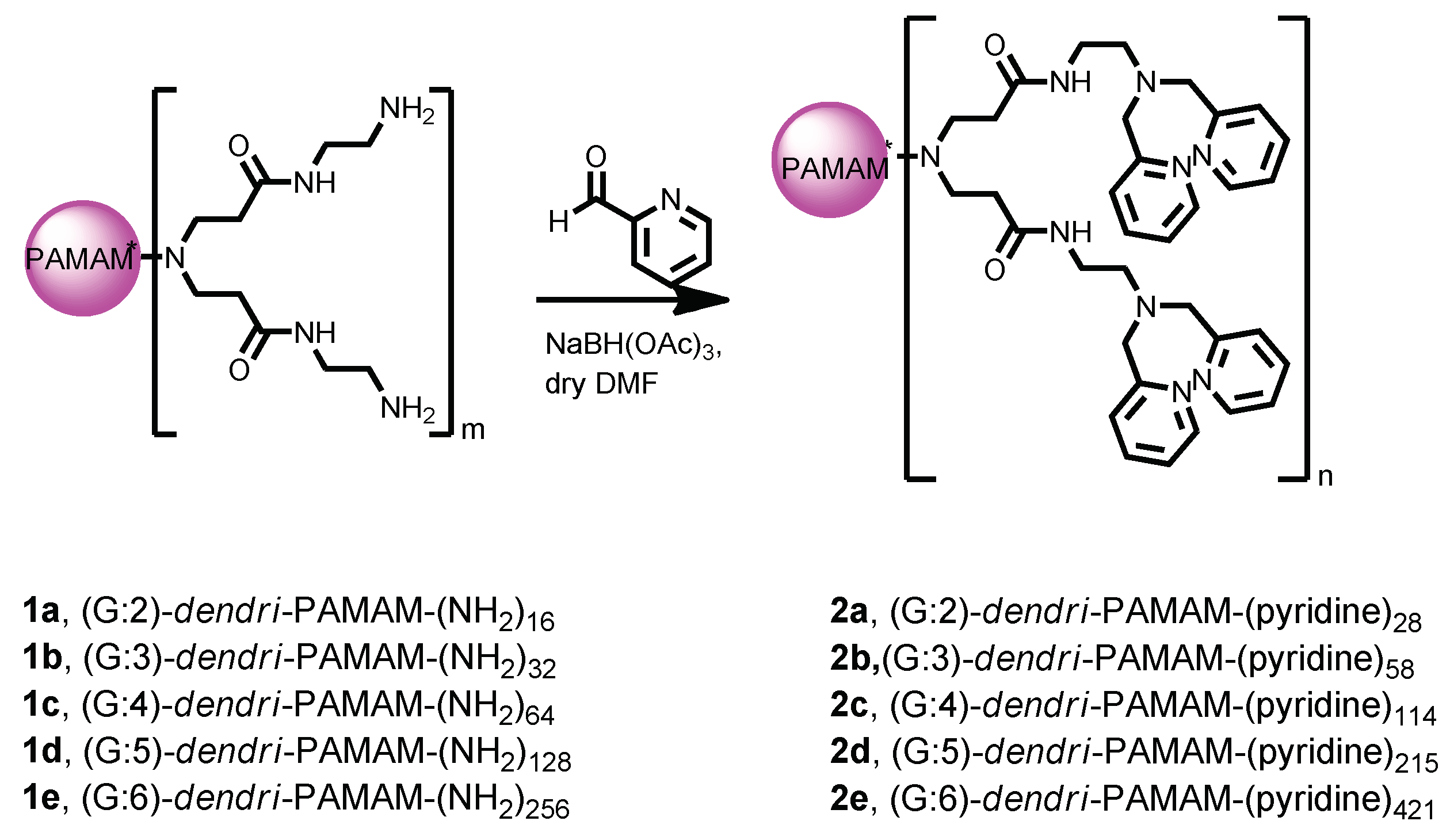
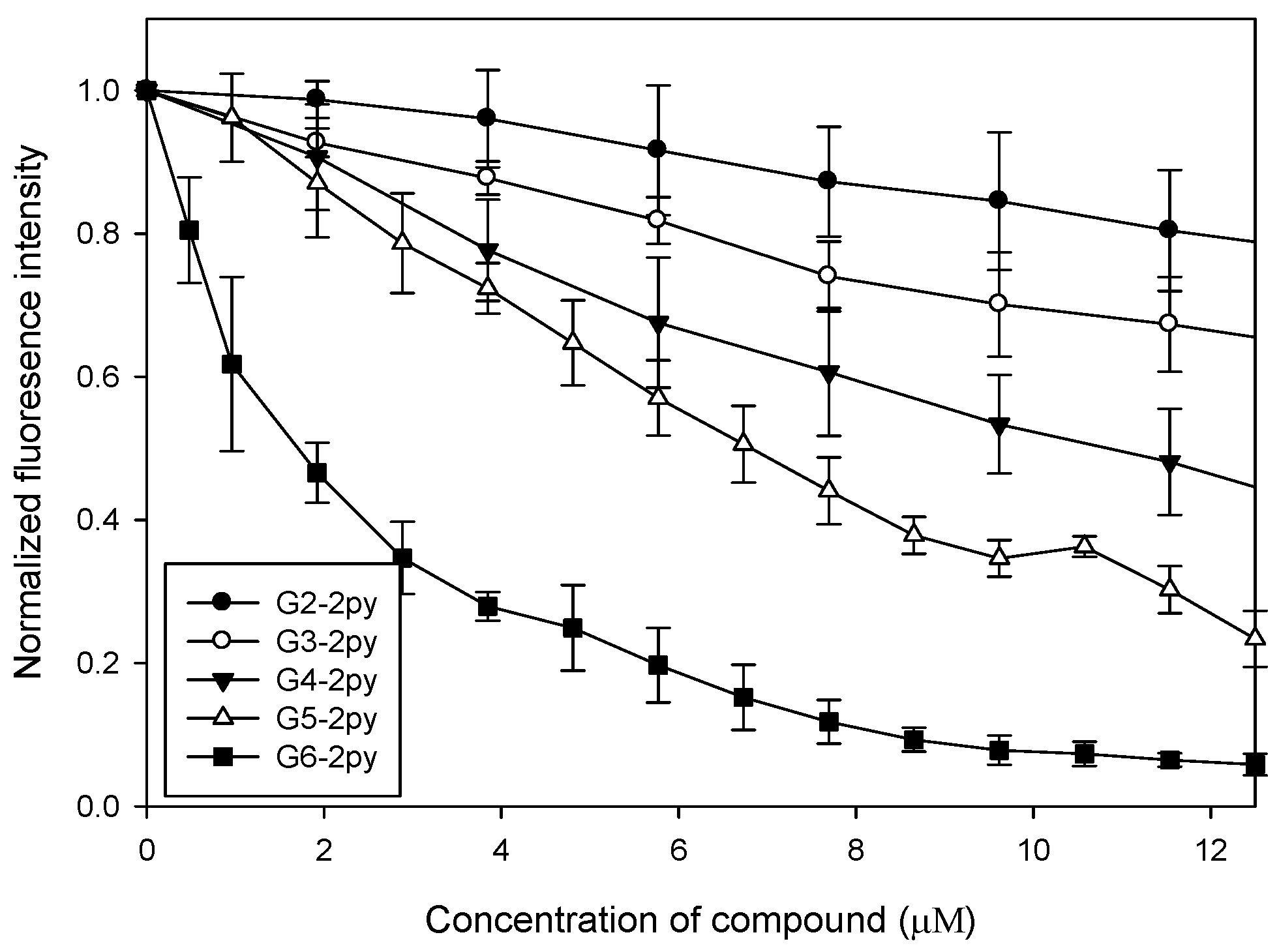
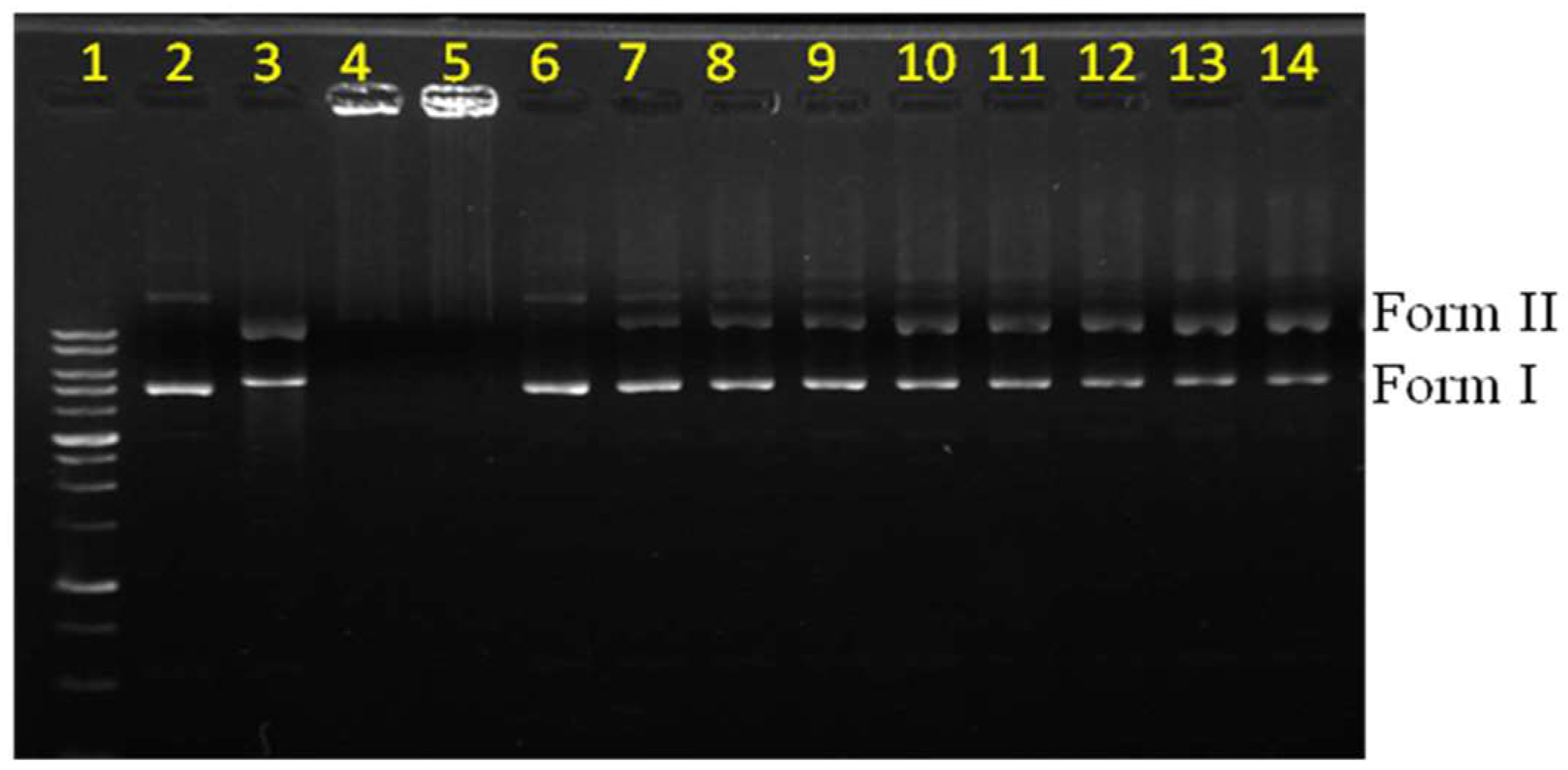
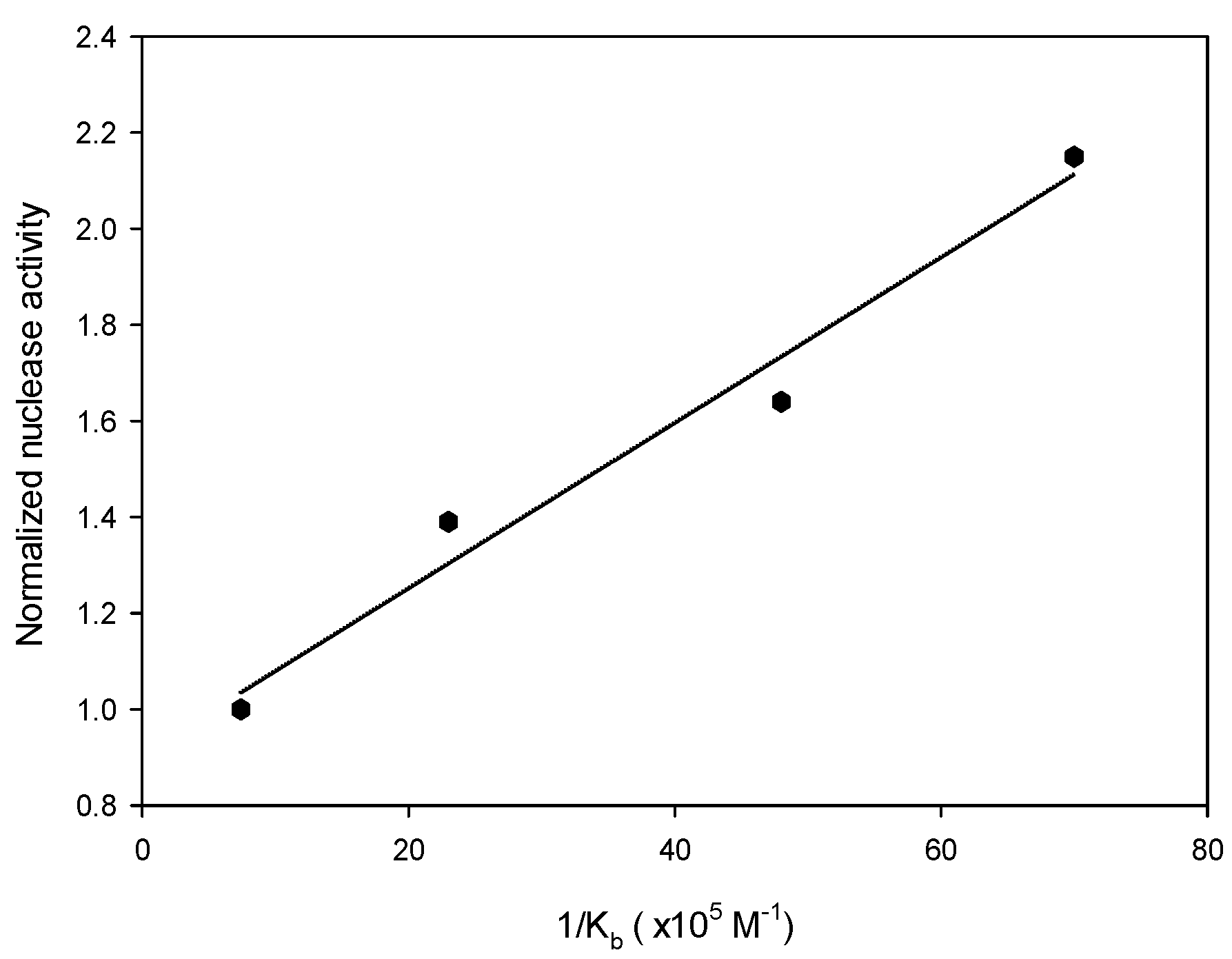

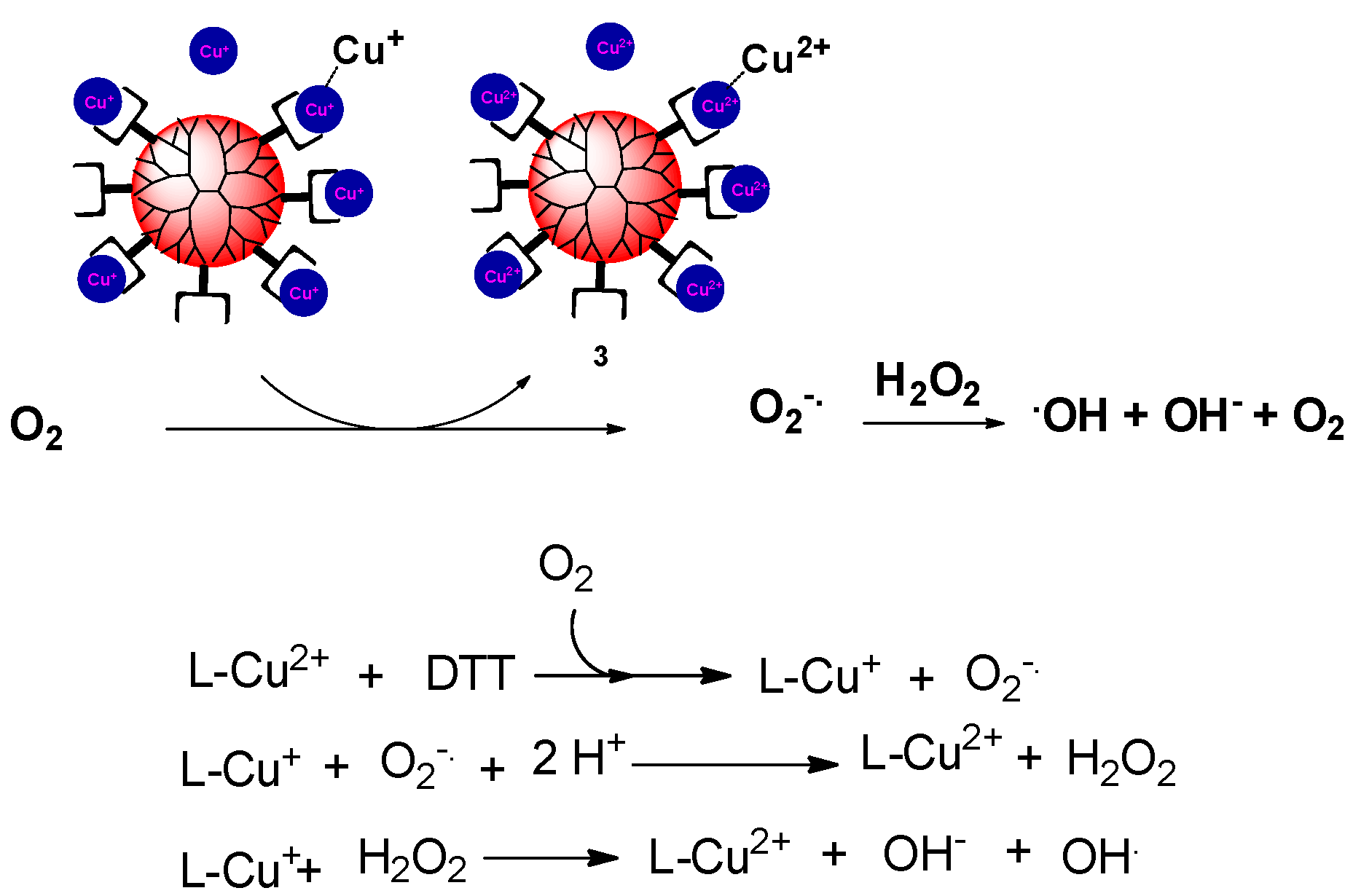
© 2018 by the authors. Licensee MDPI, Basel, Switzerland. This article is an open access article distributed under the terms and conditions of the Creative Commons Attribution (CC BY) license (http://creativecommons.org/licenses/by/4.0/).
Share and Cite
Tang, Y.-H.; Hsu, S.C.N.; Chen, P.-Y.; Liou, S.-t.; Chen, H.-T.; Wu, C.H.-Y.; Kao, C.-L. Importance of Binding Affinity for the Activity of a Metallodendritic Chemical Nuclease. Pharmaceutics 2018, 10, 258. https://doi.org/10.3390/pharmaceutics10040258
Tang Y-H, Hsu SCN, Chen P-Y, Liou S-t, Chen H-T, Wu CH-Y, Kao C-L. Importance of Binding Affinity for the Activity of a Metallodendritic Chemical Nuclease. Pharmaceutics. 2018; 10(4):258. https://doi.org/10.3390/pharmaceutics10040258
Chicago/Turabian StyleTang, Yi-Hsuan, Sodio C. N. Hsu, Po-Yu Chen, Si-ting Liou, Hui-Ting Chen, Carol Hsin-Yi Wu, and Chai-Lin Kao. 2018. "Importance of Binding Affinity for the Activity of a Metallodendritic Chemical Nuclease" Pharmaceutics 10, no. 4: 258. https://doi.org/10.3390/pharmaceutics10040258
APA StyleTang, Y.-H., Hsu, S. C. N., Chen, P.-Y., Liou, S.-t., Chen, H.-T., Wu, C. H.-Y., & Kao, C.-L. (2018). Importance of Binding Affinity for the Activity of a Metallodendritic Chemical Nuclease. Pharmaceutics, 10(4), 258. https://doi.org/10.3390/pharmaceutics10040258






